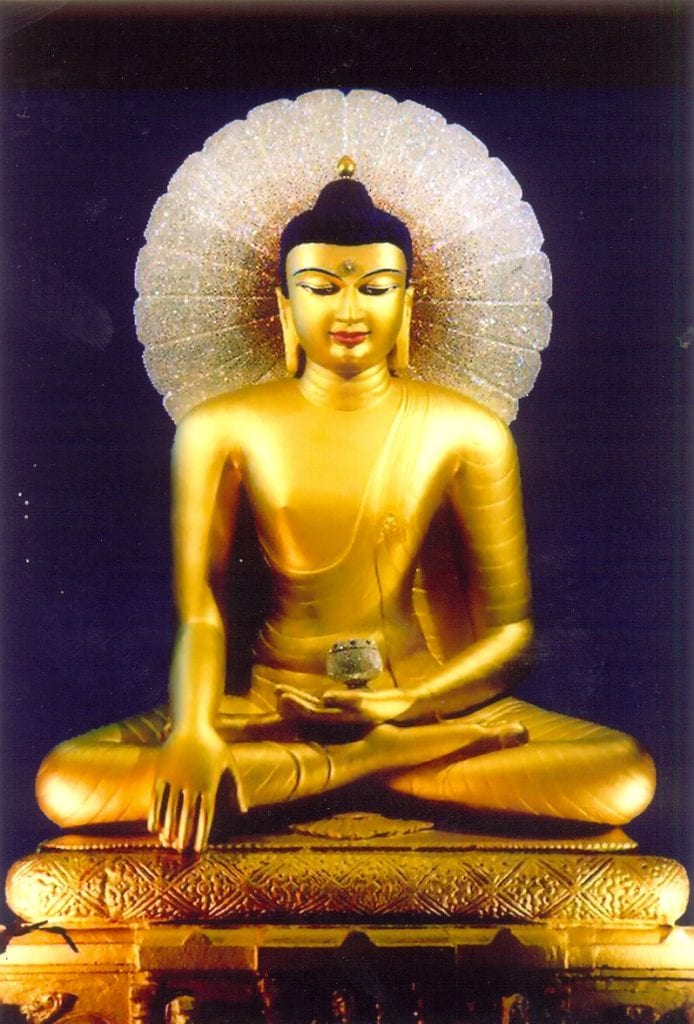In this audio clip, Phakchok Rinpoche reminds us that we need to know who we are using as a model. Who or what is the true refuge object?
True Refuge: Buddha
If we consider carefully, we can understand that the Buddha is the true refuge. Let’s examine the following quote from the Mahāyānottaratantra Śāstra, (theg pa chen po rgyud bla ma’i bstan bcos), Treatise on the Sublime Continuum. This is one of the five treatises of Maitreya, transmitted to Acharya Asanga.
In Rinpoche’s teaching he indirectly refers to this well-known quote from Chapter 1, verse 21,
Ultimately, only the buddha constitutes a refuge for beings
because that great victor is the embodiment of dharma
which is the ultimate attainment of the sangha.
By this, we can understand that the Buddha comprises all three refuges. Thus, to take refuge ultimately, we take refuge in the Buddha.
Rinpoche explains that as we begin our practice of the path, we first learn what Buddha means. He notes that this can be understood on many different levels, but here Rinpoche focuses on the Buddha’s presence and activities.
First, Rinpoche reminds us to consider the form of the Buddha by looking at an image. We practice by simply gazing at the image, letting our eyes absorb all the features.

Images of the Buddha are carefully drawn or sculpted to emphasize certain physical characteristics. There are many details we could review, and you may study the 32 major and 80 minor marks of a Buddha that correspond to specific qualities.
The 32 major marks are found throughout Buddhist literature and are described in the Pāli canon in the Lakkhaṇa Sutta. The 80 secondary characteristics are also found throughout the tradition, and they are said to be more elaborate descriptions of the Buddha’s body.
Major Marks of a Buddha
- Level feet
- Thousand-spoked wheel sign on feet
- Long, slender fingers
- Pliant hands and feet
- Toes and fingers finely webbed
- Full-sized heels
- Arched insteps
- Thighs like a royal stag
- Hands reaching below the knees
- Well-retracted male organ
- Height and stretch of arms equal
- Every hair-root dark colored
- Body hair graceful and curly
- Golden-hued body
- Ten-foot aura around him
- Soft, smooth skin
- Soles, palms, shoulders, and crown of head well-rounded
- Area below armpits well-filled
- Lion-shaped body
- Body erect and upright
- Full, round shoulders
- Forty teeth
- Teeth white, even, and close
- Four canine teeth pure white
- Jaw like a lion
- Saliva that improves the taste of all food
- Tongue long and broad
- Voice deep and resonant
- Eyes dark brown or deep blue
- Eyelashes like a royal bull
- White ūrṇā curl that emits light between eyebrows
- Fleshy protuberance on the crown of the head ( uṣṇīṣa)
(List from Epstein, Ronald. Buddhist Text Translation Society’s Buddhism A to Z. 2003. p. 200)
Recalling Qualities: Meditation Technique
Rinpoche mentions several of the qualities here: the soft eyes, the joyful quality of the smile, the dignity in the position of the shoulders. Each one of these features can remind us of a particular quality. Soft eyes may remind us of love, compassion, and caring. The”jaw like a lion” might sound strange at first, but it may help you to recall firmness and resolution. We can choose one feature as a focus and study and gradually contemplate the meaning. By slowly considering these details we can begin to appreciate the characteristics representing furition as a Buddha.
It may be helpful to remember that reflection on the qualities and the form of the Buddha has been a traditional meditation technique and can be of great benefit. Buddhist masters often suggest that we focus on particular features as we gradually familiarize ourselves with the Buddha’s form.
Rinpoche speaks also about the qualities of the Buddha’s speech and his impartial love for all beings. And he makes an important point about the compassion the Buddha shows to followers. Rinpoche especially emphasizes the fact that the Buddha does not punish us for our wrongdoings or mistakes. Instead, like a kind parent, the Buddha supports the practitioner who needs help.










Responses
thank you
Thanks for this. We can always use a reminder.